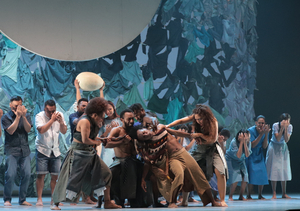Review: PLANET SEBUAH LAMENT is an Achievement and Celebration of Melanesian Art
 GARIN WORKSHOP's celebration of Melanesian art astonishes. The collaborative artistry expresses a deep love of Mother Nature through soul-wrenching laments and dances.
GARIN WORKSHOP's celebration of Melanesian art astonishes. The collaborative artistry expresses a deep love of Mother Nature through soul-wrenching laments and dances.
PLANET SEBUAH LAMENT (Planet A Lament) was born out of Garin Nugroho's obsession with the laments (mourning songs) of East Indonesia. Seven years since, he'd met other artists who would make up PLANET's creative team while working on other projects.
Among them are Septina Layan, Taufik Adam, and Nursalim Yadi Anugerah, composers who both revived nearly extinct lament songs from the far reaches of Indonesia and created new ones inspired by them. Meanwhile, the choreography - pulling from Indonesia's Papua and East Nusa Tenggara regions and beyond - is put together by Joy Alpuerto Ritter, Otniel Tasman and Boogie Papeda.
Garin admitted that the process was highly collaborative and free form. After he came up with the general structure of the play, he worked with Australian dramatist Michael Kantor to develop the script. The story tells of a tsunami that ravaged the land, leaving only a single egg as a symbol of nourishment and energy. Plastic and other manmade garbage transformed into monsters that seek to plunder the egg, forcing what's left of humanity to fight for it.
Sound-wise, the show is stunning. The laments are sung by Mazmur Chorale Choir, a choir group hailing from Kupang (the capital of East Nusa Tenggara). Interestingly, Garin deigned to have them sing a capella. Moreover, the songs were sung in various regional languages from the Melanesian region.
The vocal prowess displayed throughout the night was immensely memorable, with beautiful high notes that can bring tears, even on their own. But as the lovely voices come together in organic orchestral harmony, a kind of aural magic entranced the audience. And as no audience member was likely to even identify all the languages used, the performance really underlined the power of music to touch hearts even without cognitive understanding of the lyrics.
Likewise, the dances featured are a sight to behold. The choreography features powerful and defiant moves, each step weighty and each thrust impactful. These movements, hailing from radically different cultural history, represent a side of Indonesian art so rarely seen around Jakarta.
PLANET's production design was also a work of art on its own; crafted out of real fabrics from East Nusa Tenggara and around, the set elements were fascinating to see. A translucent screen waved and billowed, evoking images of sea waves and sails of the boats treading on them. In the back, a tapestry made out of pieces of cloth is arranged in a net-like grid, adding to the oceanic imagery.
The narrative tying these performances together was more of a theme rather than a truly coherent plot. What story was there was communicated, in addition to the aforementioned songs and dances, through a series of short films projected onto set elements. Altogether, the storytelling came across as avant garde and ambiguous, though fitting enough for the performance as a whole.
As a work of art, PLANET SEBUAH LAMENT succeeds in provoking both feelings of grief for Mother Nature and awe at humanity's potential to inspire one another. But more importantly, it showcased precious forms of art that have been ignored for too long in the national and international zeitgeist.
Just like the narrative of PLANET itself ended in a hopeful note with the survivors finding eggs as a source of nourishment, Indonesian performance artists should look into the untapped treasure of east Indonesia to further nurture the advancement of Indonesian art.
Reader Reviews
Videos

